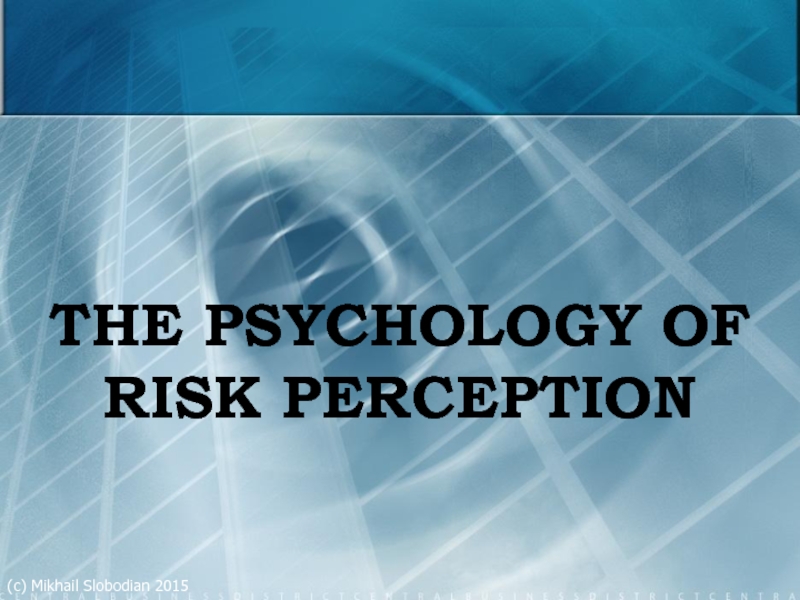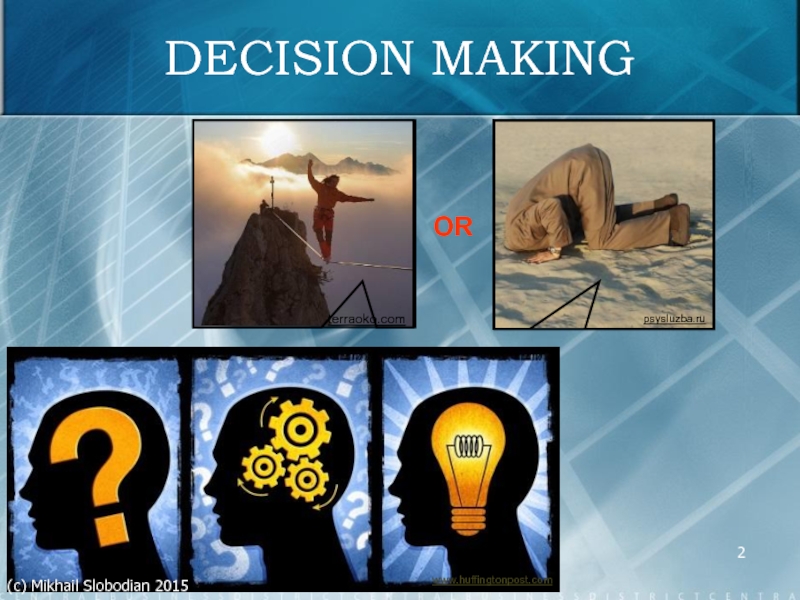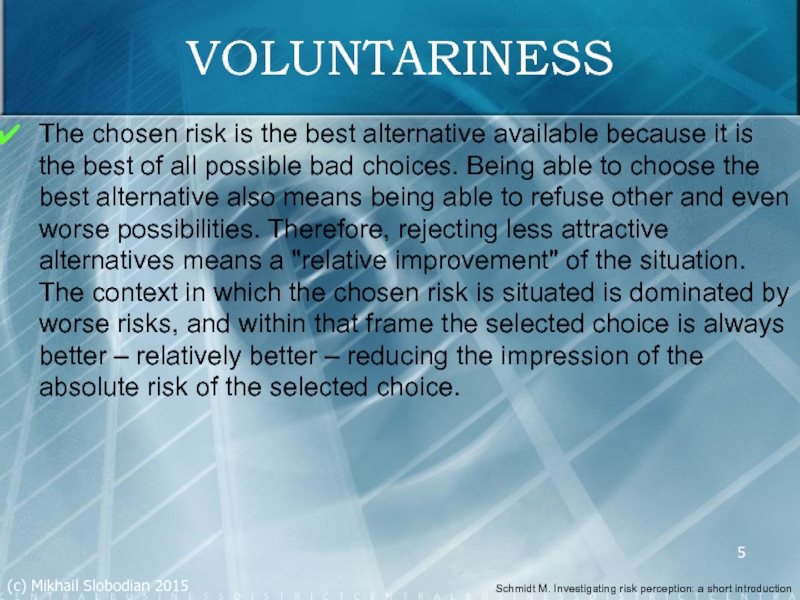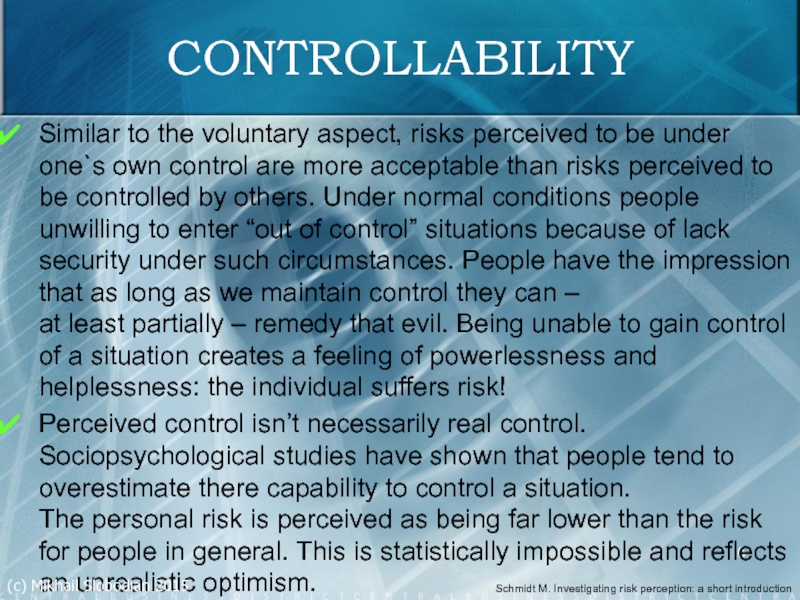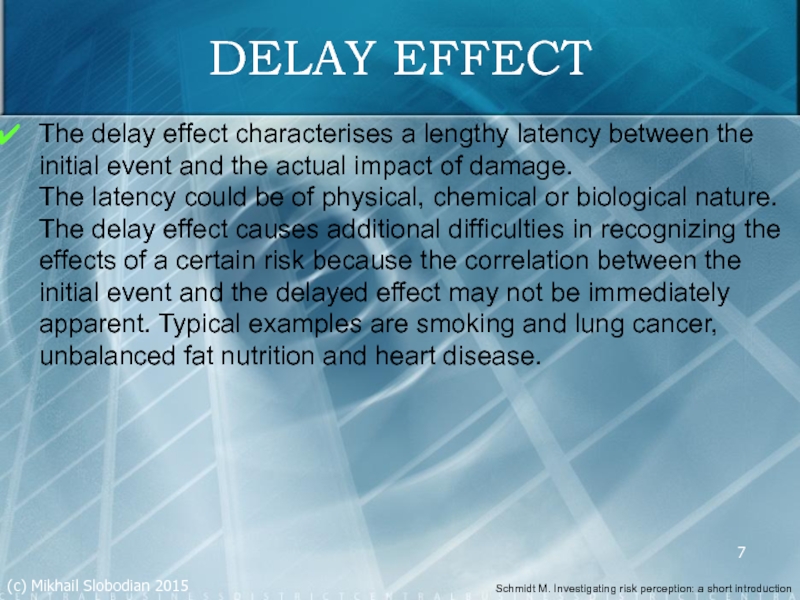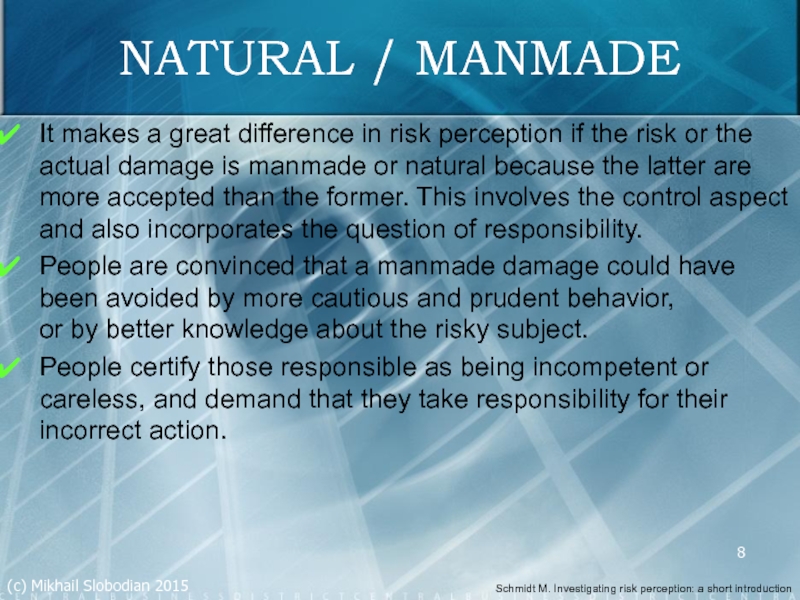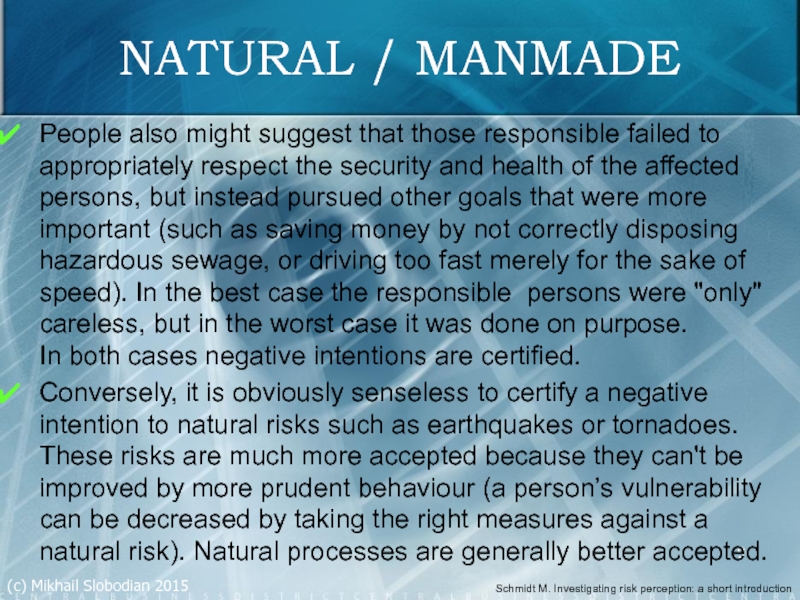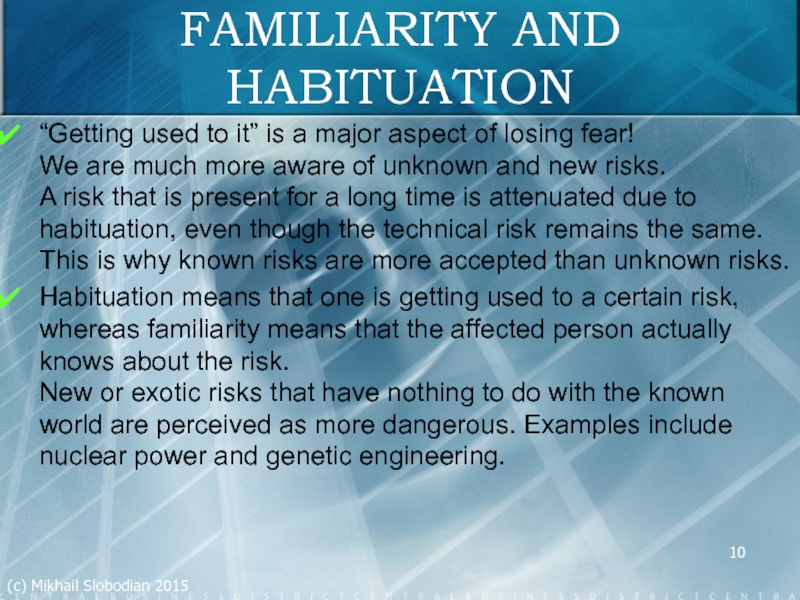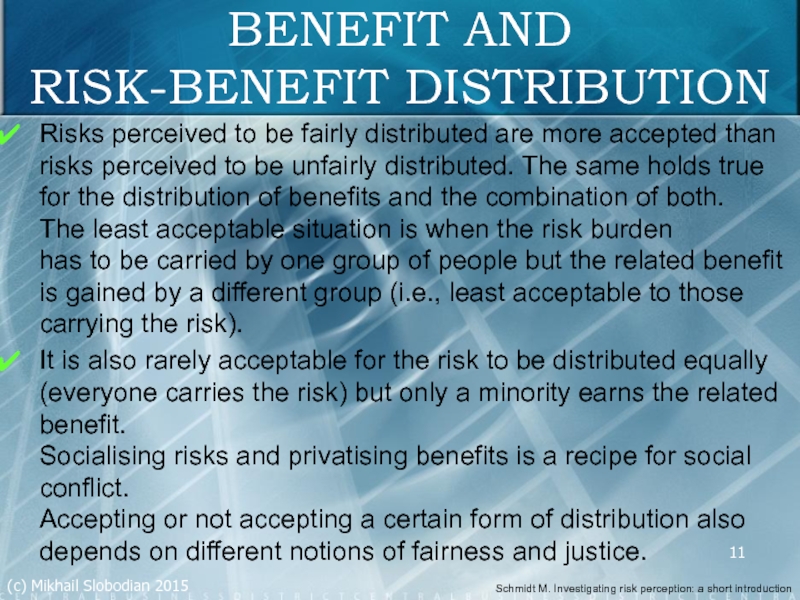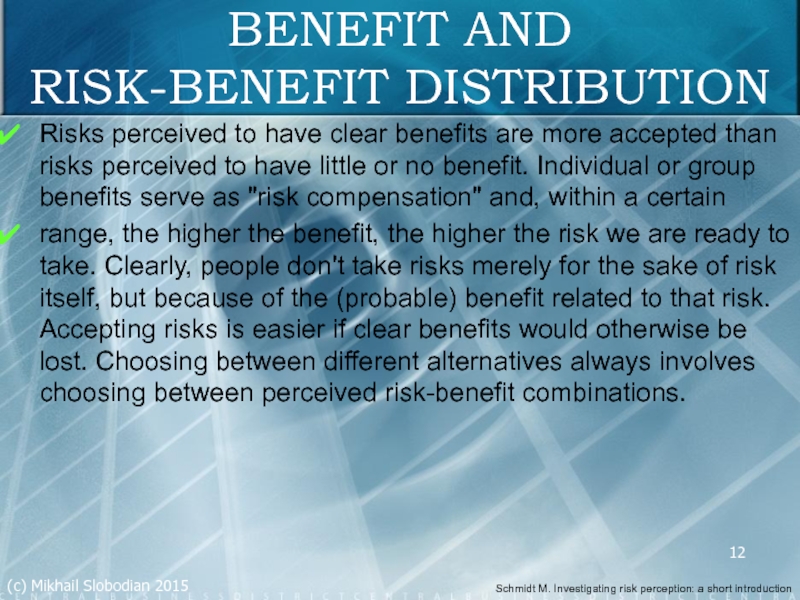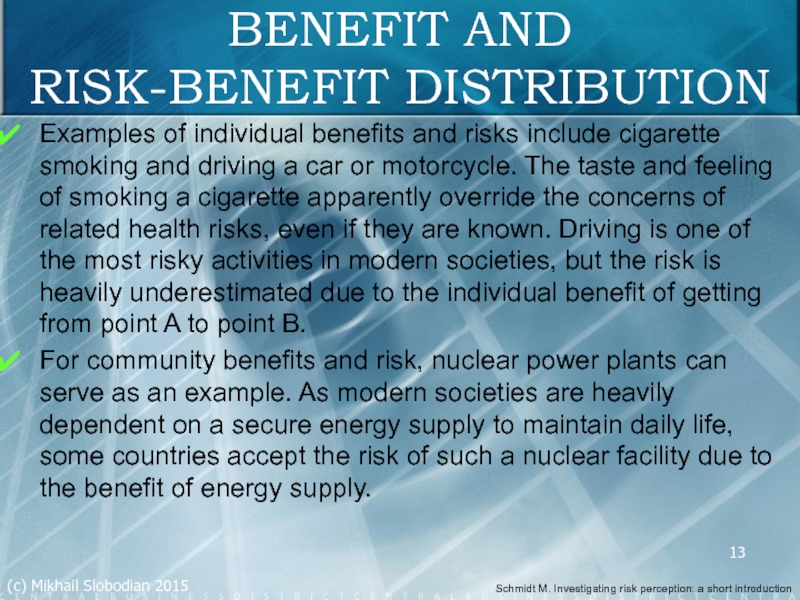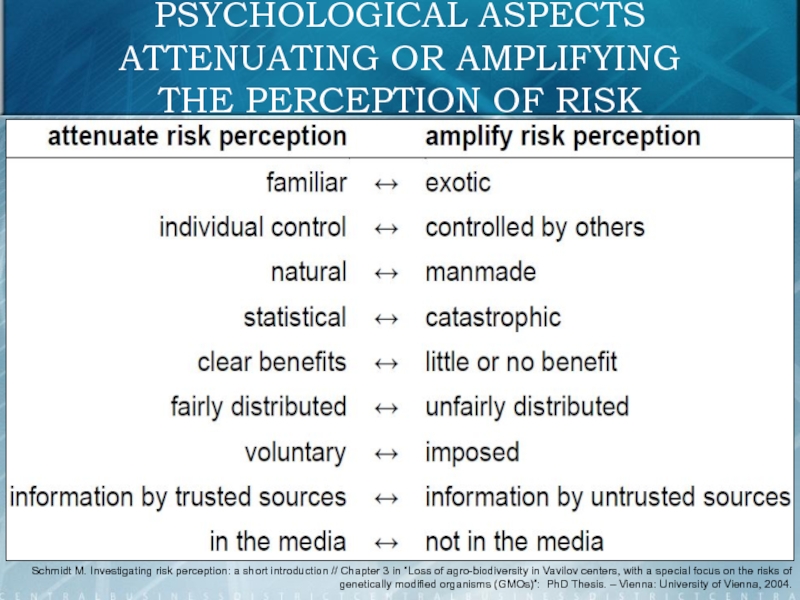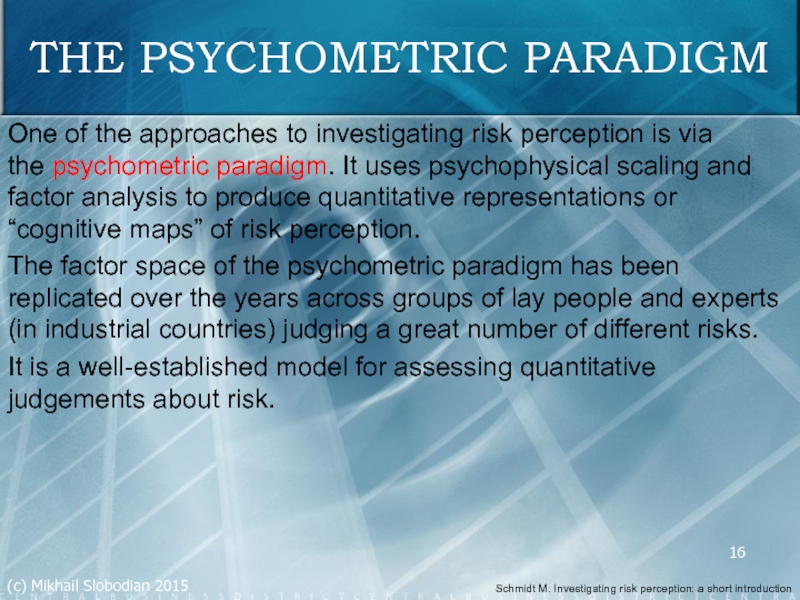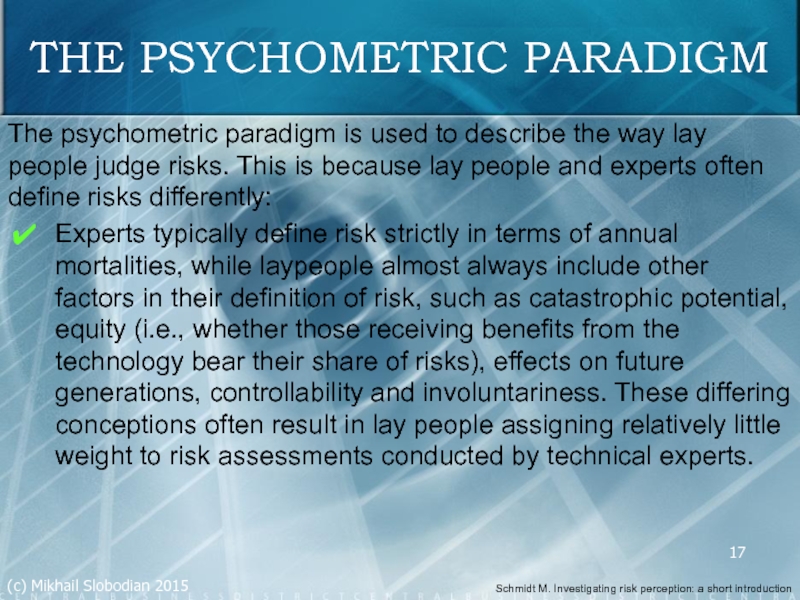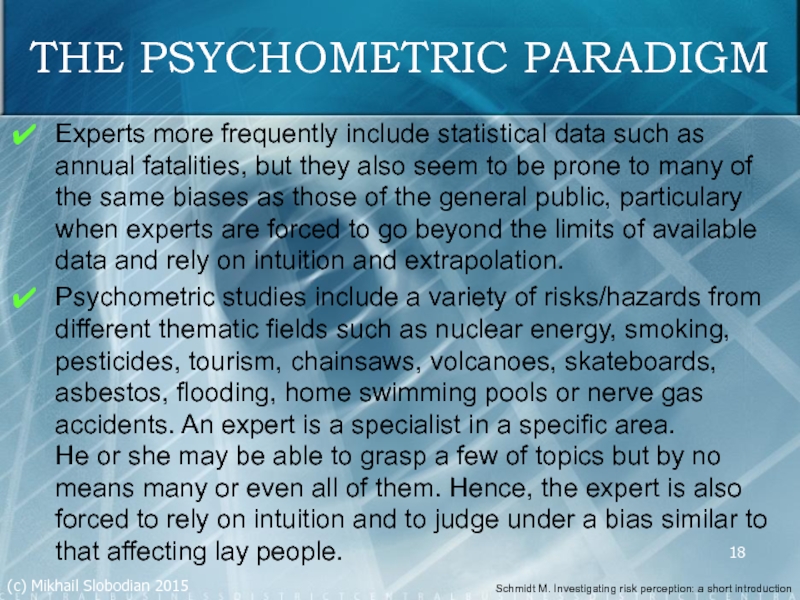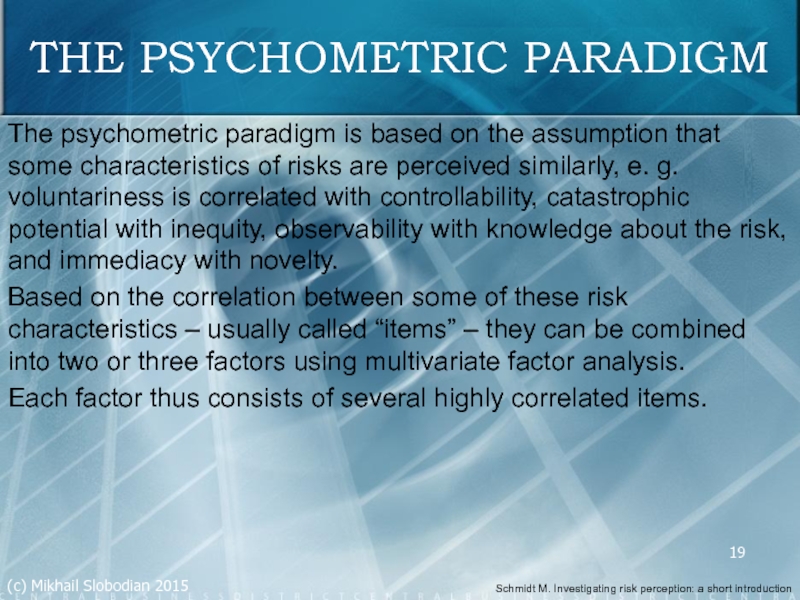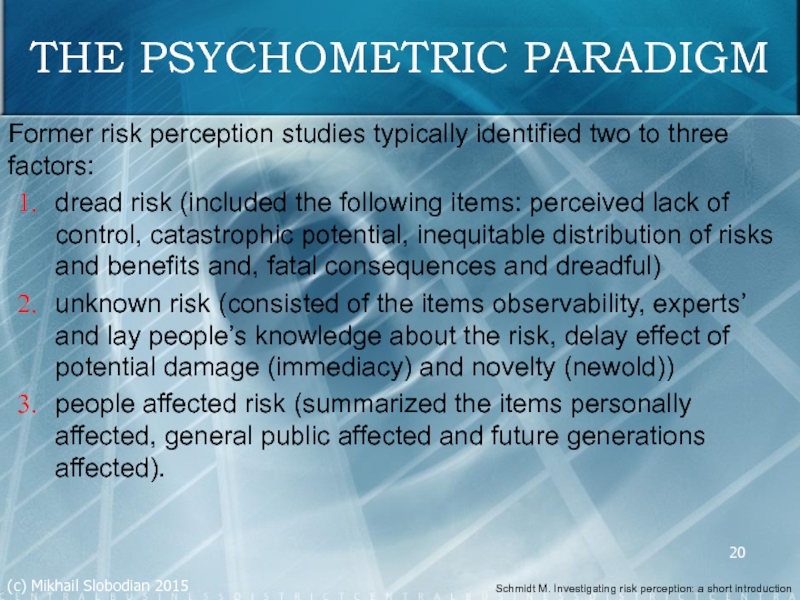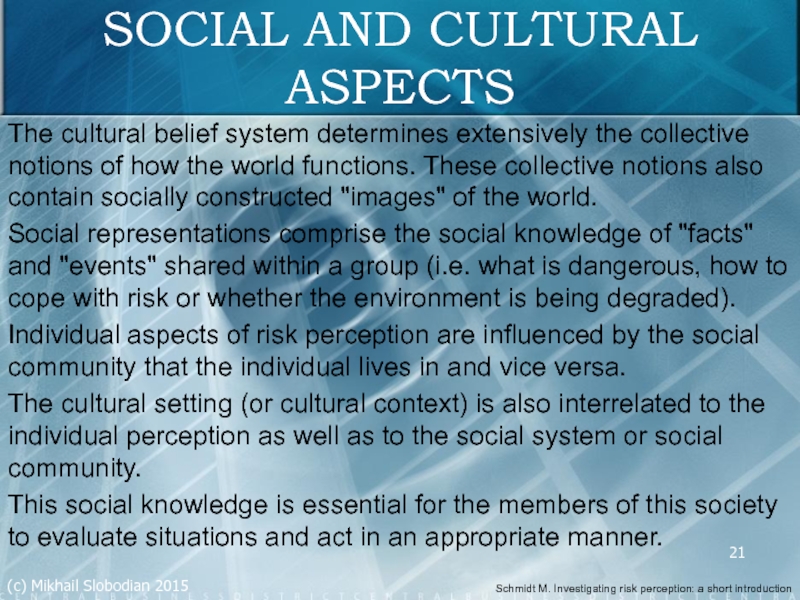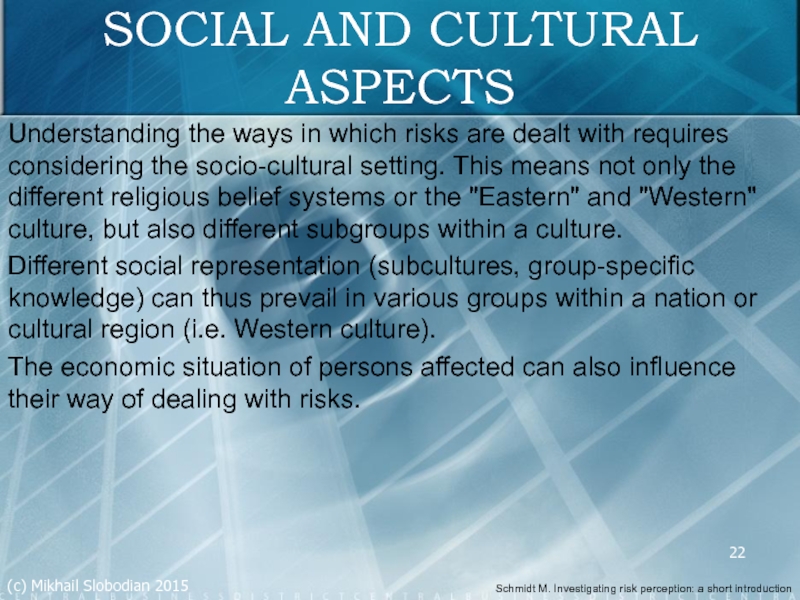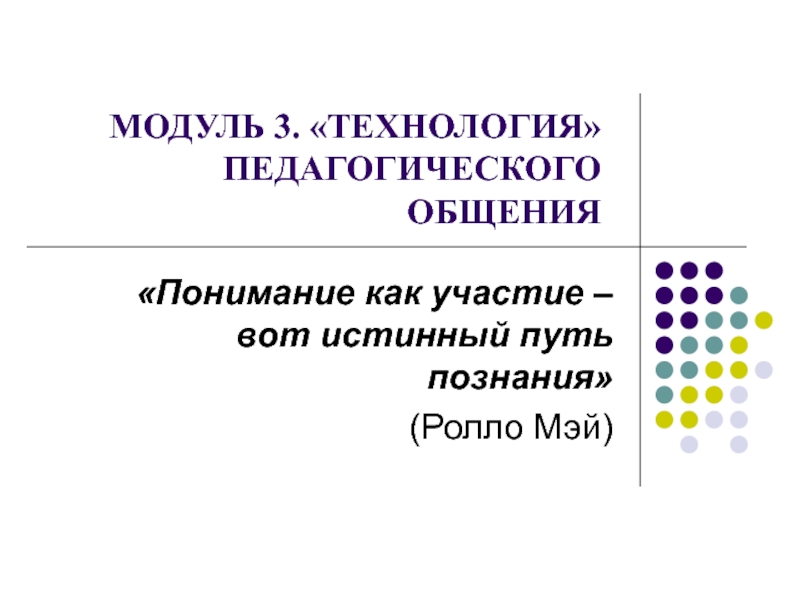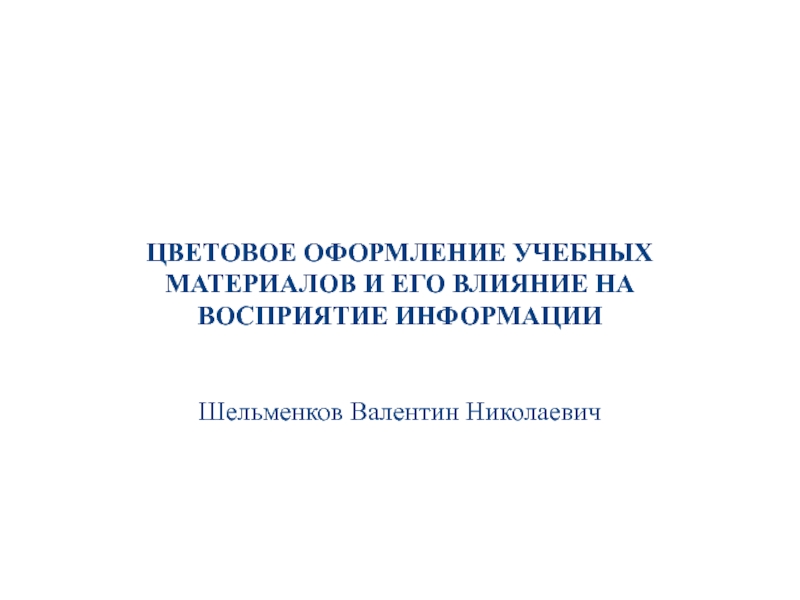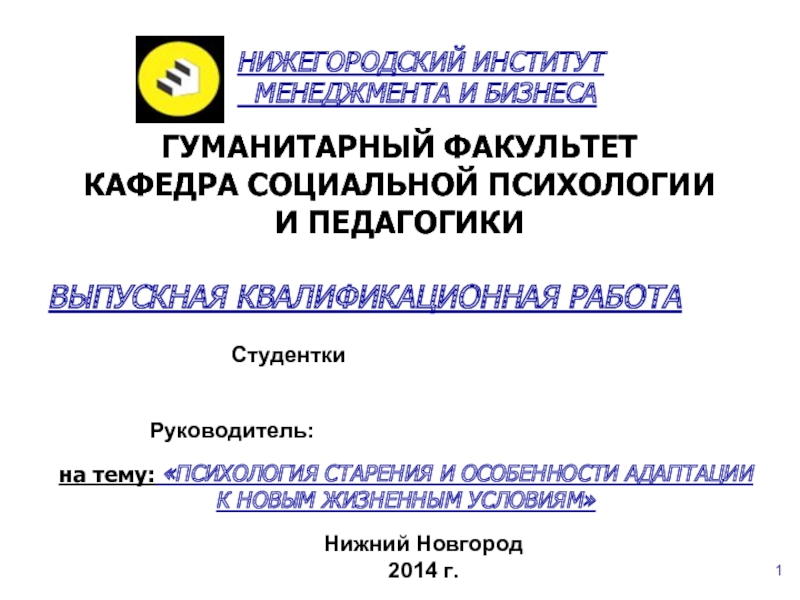- Главная
- Разное
- Дизайн
- Бизнес и предпринимательство
- Аналитика
- Образование
- Развлечения
- Красота и здоровье
- Финансы
- Государство
- Путешествия
- Спорт
- Недвижимость
- Армия
- Графика
- Культурология
- Еда и кулинария
- Лингвистика
- Английский язык
- Астрономия
- Алгебра
- Биология
- География
- Детские презентации
- Информатика
- История
- Литература
- Маркетинг
- Математика
- Медицина
- Менеджмент
- Музыка
- МХК
- Немецкий язык
- ОБЖ
- Обществознание
- Окружающий мир
- Педагогика
- Русский язык
- Технология
- Физика
- Философия
- Химия
- Шаблоны, картинки для презентаций
- Экология
- Экономика
- Юриспруденция
The psychology of risk perception презентация
Содержание
- 1. The psychology of risk perception
- 2. DECISION MAKING OR www.huffingtonpost.com terraoko.com psysluzba.ru (c) Mikhail Slobodian 2015
- 3. MAIN FACTORS IN RISK PERCEPTION
- 4. VOLUNTARINESS Perception of risk
- 5. VOLUNTARINESS The chosen risk
- 6. CONTROLLABILITY Similar to the
- 7. DELAY EFFECT The delay
- 8. NATURAL / MANMADE It
- 9. NATURAL / MANMADE People
- 10. FAMILIARITY AND HABITUATION “Getting
- 11. BENEFIT AND RISK-BENEFIT DISTRIBUTION
- 12. BENEFIT AND RISK-BENEFIT DISTRIBUTION
- 13. BENEFIT AND RISK-BENEFIT DISTRIBUTION
- 14. THE ROLE OF THE MEDIA
- 15. PSYCHOLOGICAL ASPECTS ATTENUATING OR AMPLIFYING THE PERCEPTION
- 16. THE PSYCHOMETRIC PARADIGM One
- 17. THE PSYCHOMETRIC PARADIGM The
- 18. THE PSYCHOMETRIC PARADIGM Experts
- 19. THE PSYCHOMETRIC PARADIGM The
- 20. THE PSYCHOMETRIC PARADIGM Former
- 21. SOCIAL AND CULTURAL ASPECTS
- 22. SOCIAL AND CULTURAL ASPECTS
Слайд 3MAIN FACTORS
IN RISK PERCEPTION
Voluntariness
Controllability
Delay Effect
Natural / Manmade
Familiarity and Habituation
Benefit and Risk-Benefit
The Role of the Media
(c) Mikhail Slobodian 2015
Слайд 4VOLUNTARINESS
Perception of risk is attenuated if the risk is chosen voluntarily,
If the risk is chosen and not imposed, it is a wanted risk – mainly because of some expected benefits related to that risk. The affected person is convinced that he or she would be able to stop the risk at any time.
(c) Mikhail Slobodian 2015
Schmidt M. Investigating risk perception: a short introduction
Слайд 5VOLUNTARINESS
The chosen risk is the best alternative available because it is
(c) Mikhail Slobodian 2015
Schmidt M. Investigating risk perception: a short introduction
Слайд 6CONTROLLABILITY
Similar to the voluntary aspect, risks perceived to be under one`s
Perceived control isn’t necessarily real control. Sociopsychological studies have shown that people tend to overestimate there capability to control a situation. The personal risk is perceived as being far lower than the risk for people in general. This is statistically impossible and reflects an unrealistic optimism.
(c) Mikhail Slobodian 2015
Schmidt M. Investigating risk perception: a short introduction
Слайд 7DELAY EFFECT
The delay effect characterises a lengthy latency between the initial
(c) Mikhail Slobodian 2015
Schmidt M. Investigating risk perception: a short introduction
Слайд 8NATURAL / MANMADE
It makes a great difference in risk perception if
People are convinced that a manmade damage could have been avoided by more cautious and prudent behavior, or by better knowledge about the risky subject.
People certify those responsible as being incompetent or careless, and demand that they take responsibility for their incorrect action.
(c) Mikhail Slobodian 2015
Schmidt M. Investigating risk perception: a short introduction
Слайд 9NATURAL / MANMADE
People also might suggest that those responsible failed to
Conversely, it is obviously senseless to certify a negative intention to natural risks such as earthquakes or tornadoes. These risks are much more accepted because they can't be improved by more prudent behaviour (a person’s vulnerability can be decreased by taking the right measures against a natural risk). Natural processes are generally better accepted.
(c) Mikhail Slobodian 2015
Schmidt M. Investigating risk perception: a short introduction
Слайд 10FAMILIARITY AND HABITUATION
“Getting used to it” is a major aspect of
Habituation means that one is getting used to a certain risk, whereas familiarity means that the affected person actually knows about the risk. New or exotic risks that have nothing to do with the known world are perceived as more dangerous. Examples include nuclear power and genetic engineering.
(c) Mikhail Slobodian 2015
Слайд 11BENEFIT AND
RISK-BENEFIT DISTRIBUTION
Risks perceived to be fairly distributed are more accepted
It is also rarely acceptable for the risk to be distributed equally (everyone carries the risk) but only a minority earns the related benefit. Socialising risks and privatising benefits is a recipe for social conflict. Accepting or not accepting a certain form of distribution also depends on different notions of fairness and justice.
(c) Mikhail Slobodian 2015
Schmidt M. Investigating risk perception: a short introduction
Слайд 12BENEFIT AND
RISK-BENEFIT DISTRIBUTION
Risks perceived to have clear benefits are more accepted
range, the higher the benefit, the higher the risk we are ready to take. Clearly, people don't take risks merely for the sake of risk itself, but because of the (probable) benefit related to that risk. Accepting risks is easier if clear benefits would otherwise be lost. Choosing between different alternatives always involves choosing between perceived risk-benefit combinations.
(c) Mikhail Slobodian 2015
Schmidt M. Investigating risk perception: a short introduction
Слайд 13BENEFIT AND
RISK-BENEFIT DISTRIBUTION
Examples of individual benefits and risks include cigarette smoking
For community benefits and risk, nuclear power plants can serve as an example. As modern societies are heavily dependent on a secure energy supply to maintain daily life, some countries accept the risk of such a nuclear facility due to the benefit of energy supply.
(c) Mikhail Slobodian 2015
Schmidt M. Investigating risk perception: a short introduction
Слайд 14THE ROLE OF THE MEDIA
Modern societies are highly influenced by the
the internet.
If the media reports a risk, many people suddenly become aware of it and start to worry.
If a risk topic appears in the media (news), then the risk must be real because it has made it into the media.
Risk information can be frightening even when it does not contain a warning. For example a statement by a government official meant to assure that the water is safe to drink, the air is safe to breathe, or the food is safe to eat may have the exact opposite effect. Instead of alleviating concern it may increase fear, anxiety and avoidance of an activity that previously was considered to be safe.
(c) Mikhail Slobodian 2015
Schmidt M. Investigating risk perception: a short introduction
Слайд 15PSYCHOLOGICAL ASPECTS
ATTENUATING OR AMPLIFYING
THE PERCEPTION OF RISK
Schmidt M. Investigating risk perception:
Слайд 16THE PSYCHOMETRIC PARADIGM
One of the approaches to investigating risk perception is
The factor space of the psychometric paradigm has been replicated over the years across groups of lay people and experts (in industrial countries) judging a great number of different risks.
It is a well-established model for assessing quantitative judgements about risk.
(c) Mikhail Slobodian 2015
Schmidt M. Investigating risk perception: a short introduction
Слайд 17THE PSYCHOMETRIC PARADIGM
The psychometric paradigm is used to describe the way
Experts typically define risk strictly in terms of annual mortalities, while laypeople almost always include other factors in their definition of risk, such as catastrophic potential, equity (i.e., whether those receiving benefits from the technology bear their share of risks), effects on future generations, controllability and involuntariness. These differing conceptions often result in lay people assigning relatively little weight to risk assessments conducted by technical experts.
(c) Mikhail Slobodian 2015
Schmidt M. Investigating risk perception: a short introduction
Слайд 18THE PSYCHOMETRIC PARADIGM
Experts more frequently include statistical data such as annual
Psychometric studies include a variety of risks/hazards from different thematic fields such as nuclear energy, smoking, pesticides, tourism, chainsaws, volcanoes, skateboards, asbestos, flooding, home swimming pools or nerve gas accidents. An expert is a specialist in a specific area. He or she may be able to grasp a few of topics but by no means many or even all of them. Hence, the expert is also forced to rely on intuition and to judge under a bias similar to that affecting lay people.
(c) Mikhail Slobodian 2015
Schmidt M. Investigating risk perception: a short introduction
Слайд 19THE PSYCHOMETRIC PARADIGM
The psychometric paradigm is based on the assumption that
Based on the correlation between some of these risk characteristics – usually called “items” – they can be combined into two or three factors using multivariate factor analysis.
Each factor thus consists of several highly correlated items.
(c) Mikhail Slobodian 2015
Schmidt M. Investigating risk perception: a short introduction
Слайд 20THE PSYCHOMETRIC PARADIGM
Former risk perception studies typically identified two to three
dread risk (included the following items: perceived lack of control, catastrophic potential, inequitable distribution of risks and benefits and, fatal consequences and dreadful)
unknown risk (consisted of the items observability, experts’ and lay people’s knowledge about the risk, delay effect of potential damage (immediacy) and novelty (newold))
people affected risk (summarized the items personally affected, general public affected and future generations affected).
(c) Mikhail Slobodian 2015
Schmidt M. Investigating risk perception: a short introduction
Слайд 21SOCIAL AND CULTURAL ASPECTS
The cultural belief system determines extensively the collective
Social representations comprise the social knowledge of "facts" and "events" shared within a group (i.e. what is dangerous, how to cope with risk or whether the environment is being degraded).
Individual aspects of risk perception are influenced by the social community that the individual lives in and vice versa.
The cultural setting (or cultural context) is also interrelated to the individual perception as well as to the social system or social community.
This social knowledge is essential for the members of this society to evaluate situations and act in an appropriate manner.
(c) Mikhail Slobodian 2015
Schmidt M. Investigating risk perception: a short introduction
Слайд 22SOCIAL AND CULTURAL ASPECTS
Understanding the ways in which risks are dealt
Different social representation (subcultures, group-specific knowledge) can thus prevail in various groups within a nation or cultural region (i.e. Western culture).
The economic situation of persons affected can also influence their way of dealing with risks.
(c) Mikhail Slobodian 2015
Schmidt M. Investigating risk perception: a short introduction
